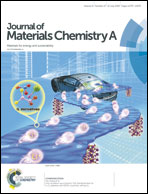Precise nanopore tuning for a high-throughput desalination membrane via co-deposition of dopamine and multifunctional POSS†
Abstract
The demand for fractionating organic molecules and salt ions via a membrane is increasing in various industries, but the sub-nanoscale difference in solute size makes it a critical challenge. Herein, amino-functionalized polyhedral oligomeric silsesquioxane (POSS) nanoparticles were employed as a molecular-level regulator to manipulate the nanopores of a polydopamine (PDA) membrane via a facile co-deposition process. By physical intercalation and chemical bonding of multifunctional POSS, increased nanoporosity was achieved within a narrow mean nanopore size range of 1.04–1.07 nm. The optimized POSS-PDA/PAN membrane exhibited desirable dye rejection (>90%) and salt permeation (>90%) with a high permeance of 1099 L m−2 h−1 MPa−1, which was 2–4 times higher than that of previously reported membranes with a similar dye rejection. Additionally, the rigid cage-like POSS nanoparticles cross-linked with the PDA membrane contributed to the reinforced alkali and compaction resistance. The synergy of mussel-inspired chemistry and multifunctional nanomaterials provided a novel strategy to engineer nanoporous membranes with a favorable physiochemical nanostructure for efficient and selective transport of both molecules and ions.



 Please wait while we load your content...
Please wait while we load your content...